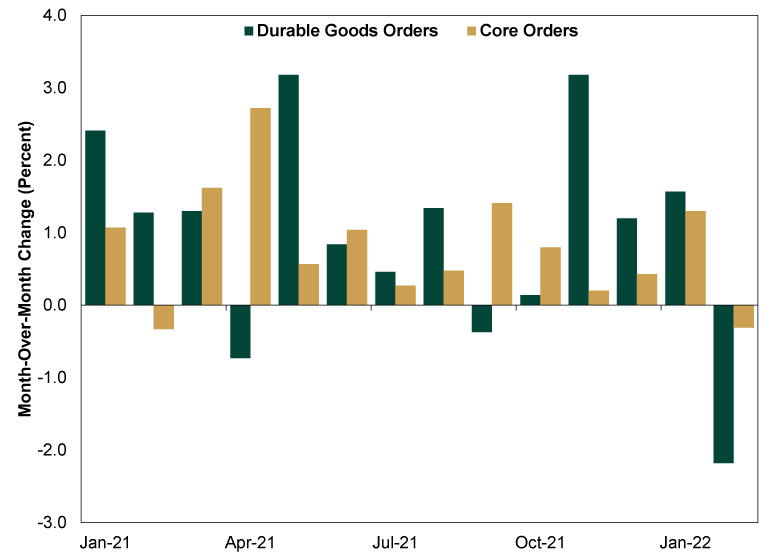Personal Wealth Management / Market Analysis
Checking In on PMIs, US Durable Goods and UK Retail Sales
How are developed economies holding up in the face of myriad headwinds?
As we approach Q1’s close, discussions about the global economy’s health abound. Besides ongoing concerns about rising prices, supply bottlenecks and COVID outbreaks, Russia’s invasion of Ukraine added a new wildcard. While dour projections are myriad, it is important to focus on actual data—and we got a bunch last week. Here we break down both the numbers and the broad reaction to them.
March PMIs Flash Some Positive Signs
First up: S&P Global’s March flash purchasing managers’ indexes (PMIs)—the artists formerly known as IHS Markit PMIs.[i] Despite a few soft patches, they broadly showed continued growth across the developed world.
Exhibit 1: March Flash PMIs

Source: S&P Global, as of 3/28/2022.
PMIs above 50 imply expansion, and March’s preliminary results surprised largely to the upside. Many projected weaker readings due to Russia-Ukraine fallout—both directly (due to the eurozone’s reliance on Russian gas) and indirectly (the potential spillover effect on already strained global supply chains).
Now, the war has weighed on economic activity to an extent, particularly in eurozone nations: Germany’s composite PMI dipped a point to 54.6 as manufacturing businesses reported slower growth due to supply problems and weaker demand tied to the conflict. But many pundits have argued the eurozone risked a recession due to Ukraine-related disruptions (e.g., soaring energy costs would crimp growth). So far, PMI data argue against that. A major escalation in the war could hurt a larger share of global GDP, but that is only a possibility, not a probability, today.
There is also an offset to the war’s negative economic impact right now: easing COVID restrictions. Reopenings benefit the services sector in particular—especially those in people-facing industries (e.g., hospitality and travel)—and March’s flash PMIs highlighted this positive trend. France’s composite PMI hit an eight-month high thanks primarily to services’ growth, and the UK’s reopening buoyed its services PMI to a nine-month high as workers returned to the office, which boosted urban foot traffic, and demand increased for travel and leisure activities. While Japan’s services PMI indicated contraction, businesses there reported a milder decline in output thanks to falling COVID cases and the lifting of the quasi-state of emergency across the country.
PMIs reveal the breadth of growth, not its magnitude, so perhaps Q1 economic output slowed or even contracted in some nations—we will know only when hard data come out. But the latest PMIs suggest economic activity is holding up better than many appreciate.
What to Make of US Durable Goods Orders’ Dip?
US February durable goods orders fell -2.2% m/m, their first dip in five months.[ii] Moreover, the widely watched “core” orders component—nondefense capital goods orders excluding aircraft, which many treat as a proxy for business investment—fell -0.3%, its first decline in 12 months.[iii] Economists pinned the drop-off on two volatile categories: motor vehicles and parts (-0.5% m/m) and nondefense aircraft and parts (-30.4%).[iv]
Some worry headwinds—e.g., the Russia-Ukraine war or new COVID outbreaks in China—could knock durable goods demand, though this seems a bit premature. For one, not all categories were weak, as defense capital goods orders rose 14.2% m/m in February after registering 18.5% m/m growth in January.[v] Defense aircraft and parts soared 60.1% m/m last month, and the surge in demand was likely due at least partially to the conflict in Eastern Europe.[vi] Two, a single monthly dip doesn’t negate the growthy longer-term trend. (Exhibit 2) Durable goods orders’ resilience has persisted despite supply shortage and bottleneck issues over the past year, and we doubt the Russia-Ukraine war is the gamechanger that derails demand.
Exhibit 2: Durable Goods Orders and “Core” Orders, January 2021 – February 2022

Source: FactSet, as of 3/28/2022.
UK Retail Sales: More Than a Case of Rising Prices
As we highlighted in MarketMinder’s “Headlines” section last Friday, UK retail sales volumes—which measures the quantity bought—dipped -0.3% m/m in February, short of expectations of 0.2%.[vii] Since retail sales values (which reflect the amount spent) rose 0.7% m/m, some economists argued elevated prices were now taking a bite out of UK consumers’ spending power.[viii] But reality is more complicated, in our view. Some spending shifted away from food stores (-0.2% m/m) as the UK ended its most recent COVID restrictions, allowing people to dine out again.[ix] Since the UK doesn’t track food service (e.g., restaurants and pubs) in its retail sales report, that shift detracted from the headline number. Excluding food stores, sales volumes rose 0.6% m/m. The ONS also noted some retailers reported less foot traffic due to February’s stormy weather, and we have seen how inclement weather has impacted economic data before—remember 2018’s Beast from the East?
In our view, this is a timely reminder to dig beyond the dominant headline—in this case, elevated inflation. We don’t dismiss rising prices, as they are likely impacting many households’ spending decisions today. But higher inflation is but one factor impacting consumers’ choices. Recognizing headlines don’t tell the whole story can help investors filter through the noise—and determine whether reality aligns with the consensus view or not.
If you would like to contact the editors responsible for this article, please message MarketMinder directly.
*The content contained in this article represents only the opinions and viewpoints of the Fisher Investments editorial staff.
Get a weekly roundup of our market insights
Sign up for our weekly e-mail newsletter.

You Imagine Your Future. We Help You Get There.
Are you ready to start your journey to a better financial future?

Where Might the Market Go Next?
Confidently tackle the market’s ups and downs with independent research and analysis that tells you where we think stocks are headed—and why.





